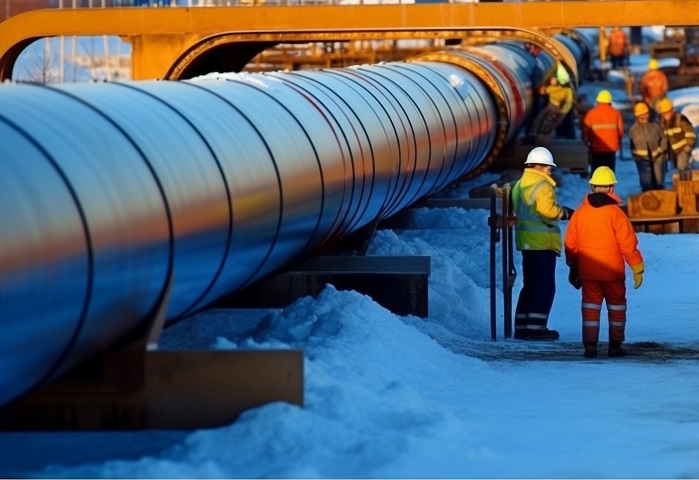 In the vast landscape of energy transportation, a tale of two pipelines unfolds – the oil pipeline and the gas pipeline. Similar to divergent paths, these pipelines carry vital resources to power our modern world. As we embark on this journey of exploration, we will uncover the intriguing distinctions that set them apart. Imagine standing amidst the sprawling oilfields, where used oilfield pipes lay weathered and seasoned by their previous adventures. Here, we will unravel the tale of the oil pipeline and its contrasting counterpart, the gas pipeline. Let us delve into the intricacies beneath the surface, understanding the nuances that shape their purposes, functionalities, and environmental impacts. Join us as we follow the winding trail, tracing the footsteps of these great conduits.
In the vast landscape of energy transportation, a tale of two pipelines unfolds – the oil pipeline and the gas pipeline. Similar to divergent paths, these pipelines carry vital resources to power our modern world. As we embark on this journey of exploration, we will uncover the intriguing distinctions that set them apart. Imagine standing amidst the sprawling oilfields, where used oilfield pipes lay weathered and seasoned by their previous adventures. Here, we will unravel the tale of the oil pipeline and its contrasting counterpart, the gas pipeline. Let us delve into the intricacies beneath the surface, understanding the nuances that shape their purposes, functionalities, and environmental impacts. Join us as we follow the winding trail, tracing the footsteps of these great conduits.
Harnessing Energy: Letting Used Oilfield Pipe Suppliers Reveal Power Sources
One notable divergence between oil and gas pipelines lies in their power sources. Oil pipelines rely on pumps fueled by electricity, diesel engines or even natural gas, ensuring a continuous oil flow through the pipeline. In contrast, gas pipelines utilize compressor stations powered by natural gas turbines, compressing the gas at various intervals along the pipeline.
Flowing with Precision: Unlocking Efficiency and Integrity in Pipeline Flow Speed
Flow speed requirements set oil pipelines and gas pipelines apart. Oil pipelines operate at lower flow velocities, guaranteeing stability and integrity while transporting various fluids, including those flowing through used oilfield pipes. Conversely, gas pipelines necessitate higher flow velocities to accommodate the inherent compressibility of natural gas, ensuring an efficient and continuous delivery to end-users.
Storage Excellence Unleashed: Strategically Managing and Directly Transporting Resources
According to used oilfield pipe suppliers, oil pipelines connect to extensive storage facilities like tanks or terminals, providing ample storage capacity for crude oil and petroleum products. This infrastructure enables strategic inventory management, stabilizing oil prices during market fluctuations. Gas pipelines, in contrast, directly transport natural gas from production sources to consumers, eliminating the need for extensive storage infrastructure along the pipeline route.
Temperature Mastery: Safeguarding the Secure Transport of Energy Resources
Temperature requirements also differentiate oil pipelines from gas pipelines. Oil pipelines typically transport petroleum products at ambient temperatures, with minimal temperature variations. Conversely, gas pipelines must account for temperature changes caused by the expansion and contraction of natural gas during transportation. To ensure the safe and efficient transport of the resource, operators implement temperature control systems that maintain the gas within the desired range.
Pressure Perfected: Mastering Safe Operations with the Law of Pressure Drop
Oil pipelines and gas pipelines exhibit distinct behaviors under pressure drop conditions. In oil pipelines, pressure decreases along the pipeline due to factors like frictional losses, elevation changes, and fluid properties, maintaining a relatively consistent pressure distribution. In contrast, gas pipelines experience more rapid pressure drop due to the compressible nature of natural gas. Factors such as pipeline length, gas composition, and flow rate influence pressure drop. That necessitates careful monitoring and control for the safe and efficient operation of gas pipelines, even those incorporating used oilfield pipes.
Sustainable Paths: Navigating the Environmental Impacts of Energy Pipelines
The environmental impacts of oil pipelines and gas pipelines vary as well. Oil pipelines and used oilfield pipes are often associated with transporting crude oil and petroleum products. The potential environmental risks associated with oil pipelines include oil spills, which can contaminate water and soil and harm wildlife and ecosystems. Gas pipelines, while still having environmental considerations, primarily transport natural gas, which is known for its relatively lower carbon emissions than other fossil fuels. However, the extraction and production processes associated with natural gas can have their environmental implications.
Power Up Your Energy Infrastructure with International Pipe: Unleash the Potential!
Take your energy transportation to the next level with International Pipe! Whether you need reliable oil pipelines or efficient gas pipelines, we’ve got you covered.
- Upgrade your infrastructure with our expertise and high-quality products, including used oilfield pipes that meet industry standards.
- Take advantage of the opportunity to optimize your operations and ensure a seamless flow of resources.
- Contact us today to discuss your pipeline needs, receive expert guidance, and secure reliable solutions to propel your business forward.
Let’s build a sustainable and efficient energy future together. Visit our website or call us now to get started!
